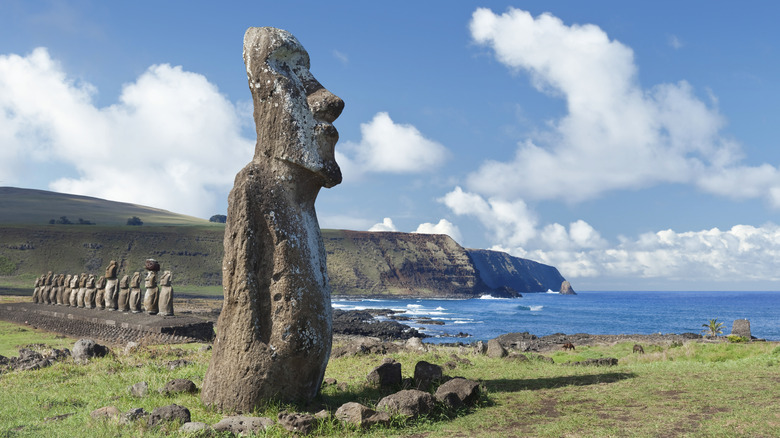Islands, with their warm shores and inviting azure waters, have long been popular destinations that promise dreamy escapes and postcard-perfect getaways. But if you want a truly unforgettable holiday, it’s time to set sail beyond the idyllic beaches and sleepy towns to embrace some of the planet’s quirkiest and most bizarre islands. Your journey will be rewarded with offbeat stories and once-in-a-lifetime experiences that boggle the mind and tickle your senses.
We scoured the internet, pulling info from tourism boards and first-hand accounts of travelers, to put together a list of places that will defy your expectations of a typical island getaway. In this quest for the extraordinary, prepare to encounter uncanny creatures, streets ruled by a feline populace, remnants from ancient transitions and spiritualism, and landscapes so surreal they could belong to another planet. These islands transcend the mainstream with a combination of natural phenomena and cultural factors, each one a testament to the unconventional beauty that awaits those willing to venture beyond the ordinary.
Socotra Island, Yemen
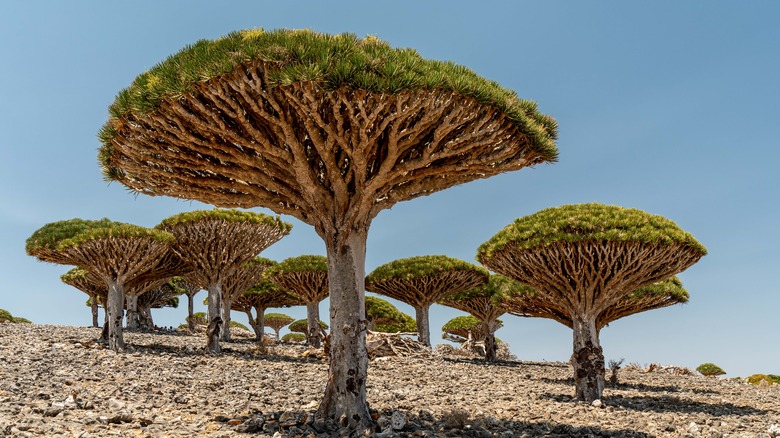
At a glance, Socotra Island’s landscape might as well be a scene from a science fiction movie. Let’s start with the eccentric tree that has become emblematic of the island. The dragon blood’s tree is a botanical wonder with a stout trunk, upturned veiny branches, and a curiously umbrella-like canopy, painting the skyline with an ethereal touch. Adding to the intrigue, these trees bleed thick red resin, which inspired its name.
Beyond that, the island is also home to 307 endemic plants that can’t be found anywhere else on the planet, making you feel like you’re on another planet altogether. But Socotra’s distinct ecosystem extends even further, featuring more endemic animals, each species more unique than the next. Nature’s peculiarities are also present in Socotra’s landscape. The mountains are covered with peculiar-looking trees and dotted by ancient villages along the mountainside, presenting an otherworldly topography where jagged ridges punctuate the skyline. Sometimes, fog rolls in from the nearby seashore, heightening the mystique. Even underground, the island displays enigmatic, intricate limestone formations that unveil the ancient geological history of the island.
Easter Island, Chile
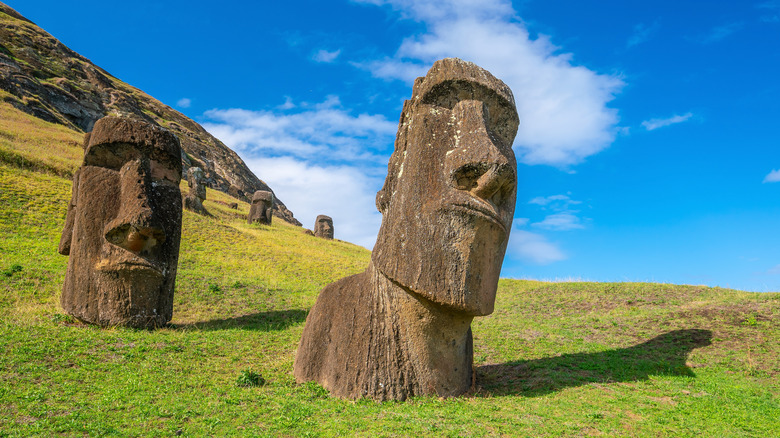
Easter Island is a remote and enigmatic outpost in the vast Pacific Ocean known for its colossal stone statues, the moai. Scattered across the landscape, the moai are stoic sentinels that guard the island’s mysteries. Carved centuries ago by the Rapa Nui people, the statues are mostly recognized for their towering heads rising from the earth, although it has been revealed that they actually have full-sized torsos buried underground.
There are at least 1,043 moai statues across the island, averaging 13 feet in height and 9.8 tons in weight, although the biggest of them can weigh up to 220 tons. The islanders, or Rapa Nui people, believed that the moai transmitted the spiritual force of the ancestors buried beneath them. But no matter where you come from, witnessing their soaring, majestic build will evoke a sense of power and mystique. One can’t help but get a sense of the power and mystique, too.
Beyond the mysteries and surrealism created by the moai statues, the island showcases other unique landscapes. The Rano Kau volcano boasts a colossal caldera that hosts a flourishing microcosm of life, while Anakena Beach presents an interesting fusion of idyllic tropical beauty and the enigmatic presence of ancient moai statues along its pristine white sands.
Tashirojima Island, Japan
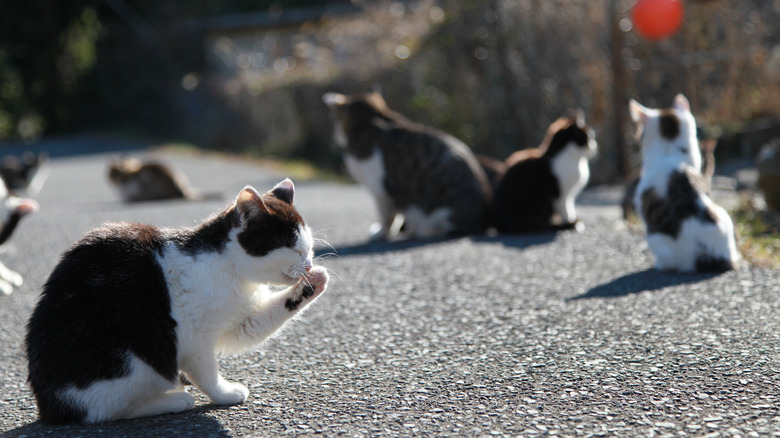
JJN2/Shutterstock
This seemingly ordinary slice of Japan is aptly known as Cat Heaven Island, a feline paradise where cats outnumber humans. Upon stepping onto the island, visitors are greeted by a whimsical spectacle — cats lounging on the streets, cats basking in the sun, cats stretching and playing, cats everywhere. The small island, covering only about 1.21 square miles, is home to more than 100 cats and only 55 human residents, mostly senior citizens.
The island’s feline inhabitants are not merely strays; they are revered and cared for by locals who believe that feeding cats brings good luck and fortune. Fully embracing the whims of a feline wonderland, islanders built a small, cat-sized shrine at the center of the island, adorned with cat-themed decorations and charms. Visitors can also immerse themselves by staying in cat-shaped cabins nestled in the southern part of the island. This lodging is called Manga Island, as it features cat-themed art drawn by famous manga artists.
Uros Islands, Peru
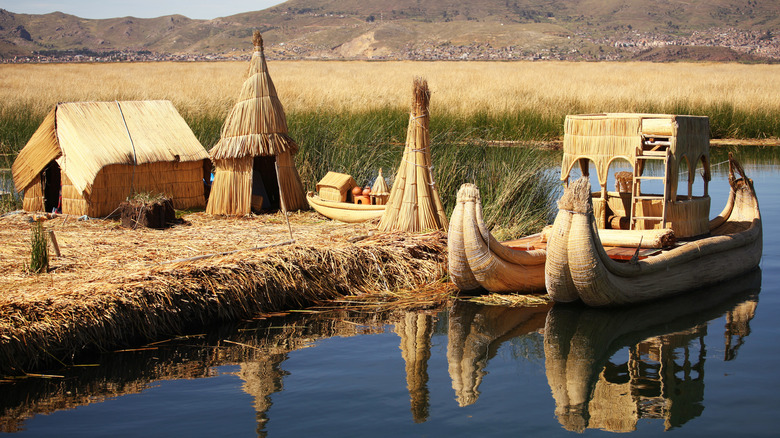
1001nights/Getty Images
The Uros Islands are situated in the heart of Lake Titicaca, which is renowned as the world’s highest lake nestled beneath the towering Andes. While that fact alone can make these islands a captivating destination for an unforgettable vacation, there’s more to discover about them.
First off, these floating islands stand as impressive feats of engineering, crafted entirely from the endemic totora reeds more than 500 years ago. Every bouncy step on these islands is a reminder of their unique origin. The indigenous Uros people built these mobile islets as a defensive measure to escape threats from the Incas. Today, there are about 120 of these man-made islands, each inhabited by up to ten families, with only some open to tourists.
The Uros people welcome tourists with a warm smile, inviting them to partake in their daily life. Visitors can learn the ancient art of reed weaving, explore the traditional reed houses, navigate the lake on their eccentric traditional reed boats, and even join in a traditional totora dance party.
Sable Island, Canada
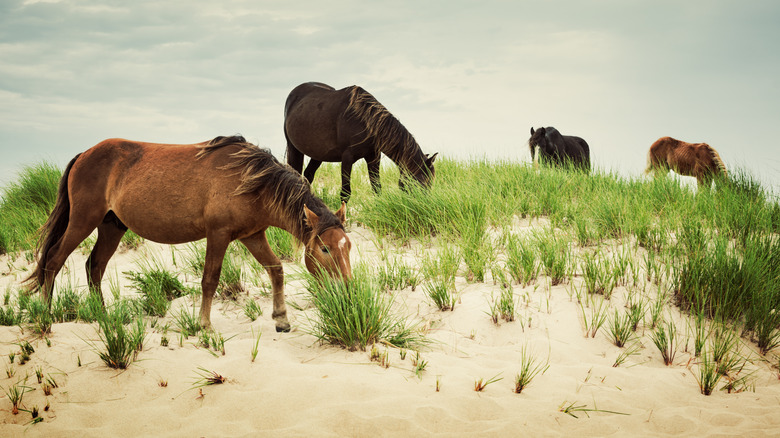
Jewelsy/Getty Images
Sable Island is uniquely shaped like a slender crescent, composed of sand dunes and windswept beaches. Its extremely remote location, 180 miles southeast of Nova Scotia, has allowed a population of mythical-looking wild horses to thrive in isolation for centuries. The Sable Island horses are a small, feral breed with shaggy coats of mostly darker colors that offer camouflage against the island’s barren landscape. More than 500 of these horses roam freely across the sandy island, and visitors are required to keep a safe distance from them. Sable Island is also home to the world’s largest colony of gray seals, as well as some endemic plants, birds, and insects.
For sailors, Sable Island is known as the Graveyard of the Atlantic, as over 350 recorded shipwrecks have occurred around this stormy island over the centuries. Some of the ship’s remains can still be found along the island’s shores until today, emerging and disappearing with its ever-shifting sandbars, adding to the island’s eerie yet captivating beauty.
Zavadovski Island, South Georgia and the South Sandwich Islands
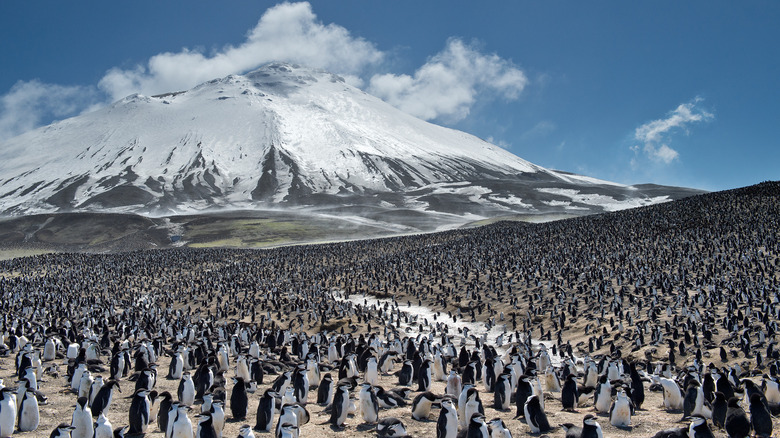
MZPHOTO.CZ/Shutterstock
Nestled in the remote reaches of the South Atlantic Ocean, Zavodovski Island is an alluring destination with untamed wilderness and vibrant wildlife. What sets this island apart is its remarkable population of penguins — a staggering 690,000 breeding pairs, making it home to the largest penguin colony on Earth. As far as the eye can see, the island’s rocky shores and slopes are overflowing with these black-and-white birds, like a bustling metropolis of penguins.
The incessant chatter and activities of the penguins create a lively contrast against the dramatic backdrop of an active volcano, creating a mesmerizing scene that looks like something straight out of a nature documentary. The ever-present volcanic activity adds an extra layer of awe, erupting and spewing boiling lava to different parts of the island from time to time.
The journey to Zavodovski Island is an adventure in itself, requiring a tiring and potentially dangerous voyage. It promises an unparalleled, unspoiled beauty reserved to the bravest and most committed adventurers. In an interview with Business Insider, Liz White, a producer of Planet Earth II, stated, “Filming on Zavodovski Island is an achievement that will stick with me forever.”
Mackinac Island, USA
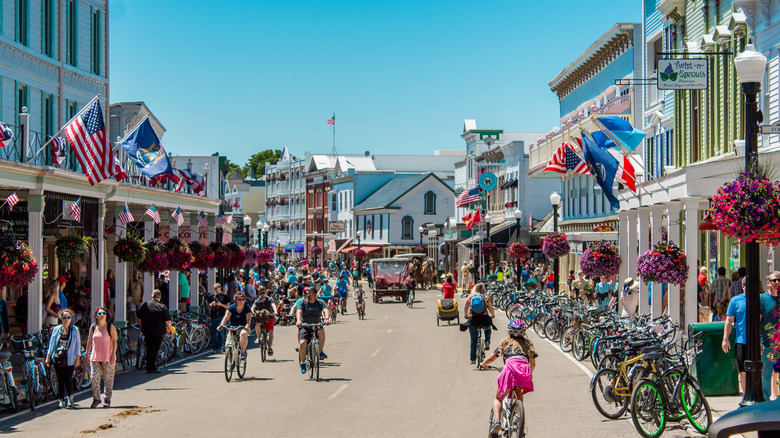
Michael Deemer/Shutterstock
Mackinac Island is a captivating anomaly in one of the most modern and advanced countries in the world. Located in the heart of Lake Huron, the island might as well be a parallel universe that is frozen in time. There are no cars in this time-warped world. Instead, horse-drawn carriages and bicycles abound to take visitors around. Other than transportation, architecture is another factor that will immerse visitors to another era. Because of its rich history, several styles can be found on this island, but the Victorian Era heritage stands out prominently, including landmarks like the iconic Grand Hotel and Doud’s Market, the country’s oldest grocery store, dating back to the 1880s.
Tradition is taken very seriously on this island. Some of the most peculiar annual events include the Lilac Festival, where the whole island celebrates the flower’s bloom with parades, tournaments, music, and other activities for 10 days. Another popular one is the Fudge Festival, when a weekend is dedicated to various fudge-themed activities, including cooking demos, eating, playing, and more.
Galápagos Islands, Ecuador
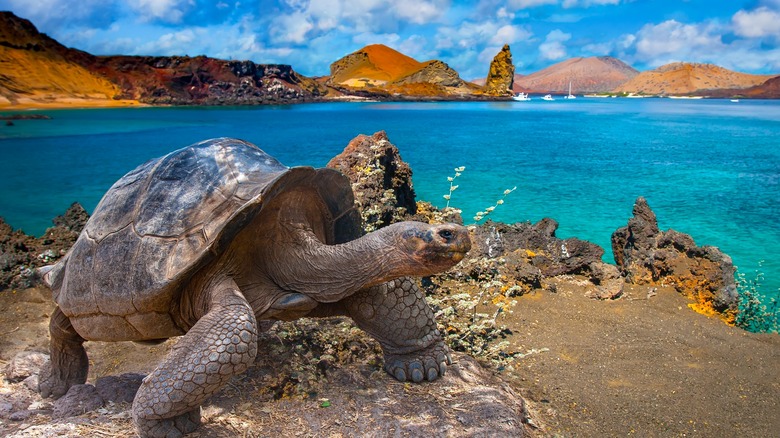
FOTOGRIN/Shutterstock
For Charles Darwin, the Galápagos Islands served as a living laboratory that inspired his theory of evolution. The islands’ thousands of years of isolation have allowed various species to evolve in strange and peculiar ways unlike anywhere else on the planet. In fact, about 80% of land birds, 97% of reptiles and land mammals, and more than 30% of plants found on the Galápagos are endemic, creating an alien atmosphere of unfamiliar creatures. Some of these species include the iconic giant tortoise that can live more than a hundred years, marine iguanas of different striking colors, and the stylish blue-footed and red-footed boobies with their comically vibrant feet.
Underwater, the Galápagos Marine Reserve, one of the largest in the world, invites divers into a realm of unparalleled biodiversity. Schools of hammerhead sharks, graceful sea turtles, and elusive marine mammals paint a vivid underwater canvas, creating an immersive experience for those daring enough to explore the depths.
Beyond its fauna, the Galápagos Islands offer surreal landscapes that seem plucked from a distant planet. Lava tunnels, moonscape-like expanses, and vibrant volcanic craters punctuate the archipelago, showcasing the geological wonders that have shaped this bizarre and beautiful ecosystem.
Ōkunoshima Island, Japan

Grassflowerhead/Shutterstock
Nestled in the Inland Sea of Japan, cuteness meets dark history in Ōkunoshima Island. Nicknamed Rabbit Island, Ōkunoshima is primarily known for its 1,000 wild yet friendly rabbit population, greeting visitors with their wiggling noses and floppy ears. Here, visitors can feed their new furry friends, take selfies, and enjoy the laid-back island life.
Explore the island further and you’ll discover that Ōkunoshima’s past wasn’t all fuzzy and snuggly. Abandoned wartime structures scattered around the island bear witness to its tragic history as a secret chemical weapons factory site in 1929. During that period, the Japanese government even removed Ōkunoshima from maps to conceal its existence. In 1988, the Poison Gas Museum was opened to the public, showcasing some blood-curdling objects used in chemical weapons productions and unmasking their terrifying tales.
Interestingly, the flourishing rabbit population on this island is tied to its gloomy history. While there’s no definitive proof, some believe that a group of rabbits was brought to the island as test subjects for chemical weapons. Others suggest that they were released onto the island after the war to detect poison gas leaks. Either way, the unique harmony between natural beauty and history makes Ōkunoshima Island a one-of-a-kind destination.
Christmas Island, Australia
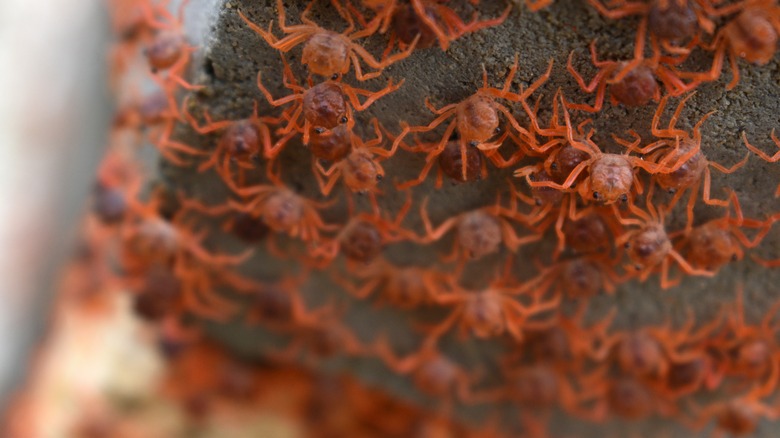
Sofia Varano/Shutterstock
In the vast expanse of the Indian Ocean lies Christmas Island, a truly bizarre gem that defies the conventions of typical island getaways. A haven for the extraordinary, this island is renowned for red crab migrations phenomena. Every year, typically between October and December, millions of crimson-colored land crabs embark on a mass journey from the forest to the ocean to spawn. During this time, the island’s landscape transforms into a fantasy land of vibrant and dynamic red, a sight not found anywhere else on the planet.
Beyond the striking red crabs, Christmas Island is also home to other eccentric species. It’s a paradise for bird enthusiasts, boasting funky-looking endemic birds like the Abbott’s Booby and the critically endangered Christmas Island Frigatebird. The island’s marine life is equally mesmerizing, boasting vibrant coral gardens and marine species beneath the crystal-clear waters, making diving and snorkeling popular tourist activities. However, a simple land exploration will also reward visitors with awe-inspiring limestone cliffs, rock pools, and other unique geological formations.
Koh Rong, Cambodia
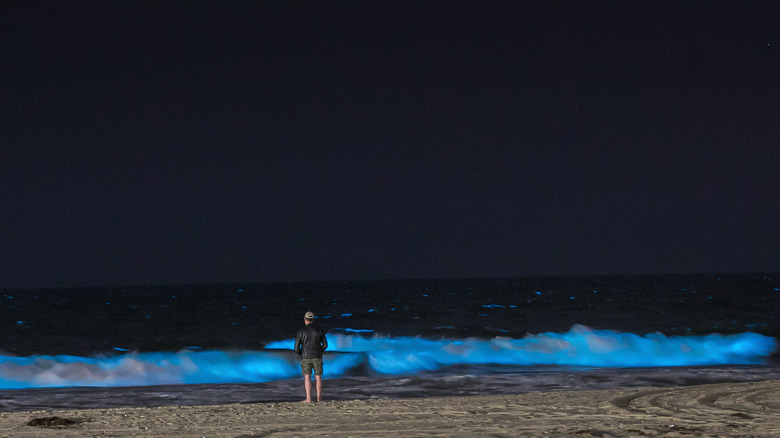
MOOZ PHOTO/Shutterstock
During the day, Koh Rong may appear as an ordinary albeit idyllic island destination, spoiling visitors with its pristine beaches and crystal-clear waters. However, as the sun sets, this Cambodian paradise reveals its otherworldly allure. As darkness settles, the island shores transform into a glowing spectacle, sparkling like a starry sky. This ethereal phenomena is caused by bioluminescent plankton that emit blue or green light when agitated by movement in the water.
Needless to say, an evening dip into the glowing waters becomes a surreal experience for many visitors, while others opt for an evening boat tour to witness the natural wonders from a more remote and dramatic vantage point. Koh Rong’s peculiar beauty doesn’t end here. The island boasts numerous secluded beaches to enjoy and dense mangrove forest to explore with a kayak. The vibrant marine life also goes beyond the plankton, drawing snorkelers and divers to its coral gardens and different species of sharks.
Haida Gwaii, Canada
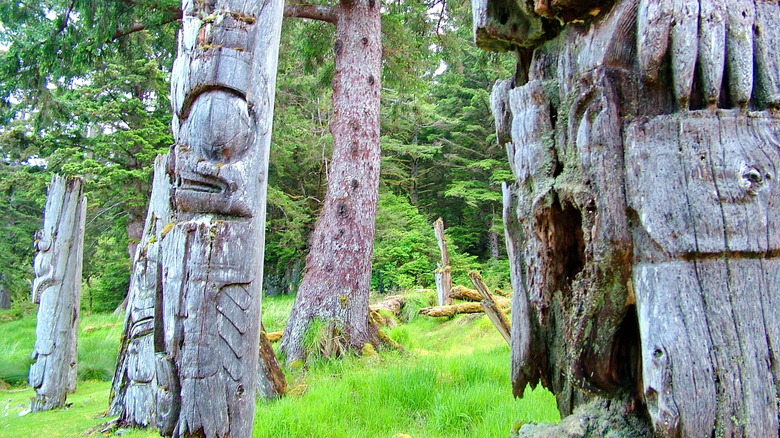
Bob Hilscher/Shutterstock
Hailed as Canada’s most mysterious island, Haida Gwaii is an archipelago off the northern coast of British Columbia. Steeped in ancient indigenous lore and surrounded by untamed natural beauty, these islands possess an air of mystery that invites explorers to uncover its secrets. Let’s begin with its deep connection to the Haida Nation, one of Canada’s oldest indigenous tribes and one of the longest traceable populations in the world.
The Haida people occupied the same land for more than 12,000 years, and artifacts adorn the islands that reflect the island’s complex history, from intricately carved totem poles to ruins of ancient villages that evoke a deep sense of reverence. Today, visitors can also engage with the Haida culture through vibrant arts, crafts, and traditional performances.
Beyond the islands’ cultural significance, visitors are also drawn to Haida Gwaii’s lush ancient rainforests, rugged coastlines, and secluded beaches. Spanning both land and sea, the ecological diversity contains several rare and endemic species, including the Haida Gwaii black bear, Sitka deer, and elusive marine creatures.
Hashima Island, Japan
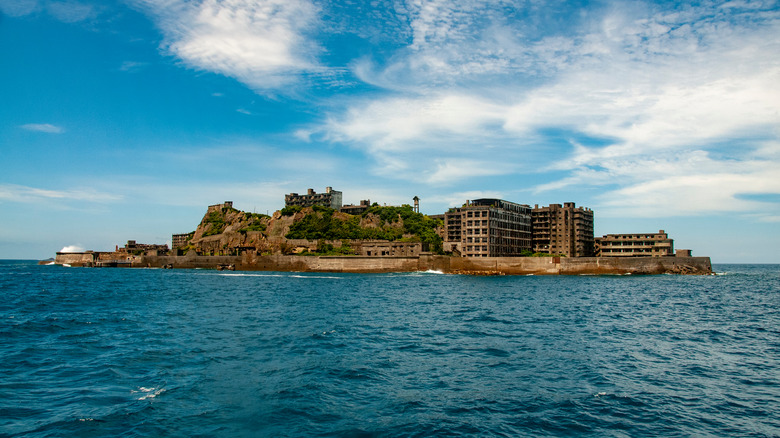
Zoblinski/Shutterstock
Once a bustling coal mining community that fueled Japan’s industrialization, Hashima, also known as Gunkanjima or Battleship Island, now stands frozen in desolation. The island’s bizarre allure lies in its eerie atmosphere, where towering, decaying buildings tell the tale of a once-thriving metropolis abruptly abandoned despite once being the most densely populated place on Earth. Hashima Island was abandoned in the 1970s as petroleum started to replace coal and the mines had to be closed permanently.
The skeletal remains of apartments, schools, and factories create a haunting urban landscape that sparks curiosity and contemplation. Other than being a tourist destination, this uncanny ghost town has been featured in several films that leverage its visually striking scenes, and it has inspired an iconic set used in James Bond’s “Skyfall” in 2012. Today, visitors can visit this island by signing up for one of the official guided tours to ensure safety while exploring this industrial decay.
Gavdos Island, Greece
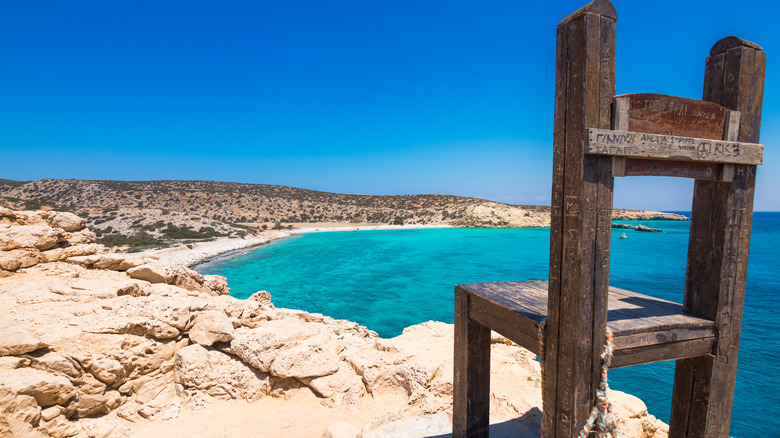
Georgios Tsichlis/Shutterstock
Gavdos Island, the southernmost tip of Europe, is a paradoxical gem — a blend of serene tranquility and an aura of mystique. Strangely, this remote haven is dotted with remnants of great empires, from the Minoan, Roman, to Byzantine civilizations, suggesting a once bustling society. In Greek mythology, it is believed that the goddess Calypso lived on this island, adding a layer of intrigue to its white sand dunes and rugged beauty. At night, the sky unfolds in a mesmerizing display of stars and constellations that become apparent with minimal light pollution.
Beyond its pristine beauty and captivating landmarks, perhaps the most fascinating thing about this island is its people. Gavdos takes pride in its small but eclectic community of free-spirited residents and transient bohemian travelers. It stands as one of few places in Greece where tourists can swim and sunbathe in the nude. In 2012, this island made international news for being the chosen site for the “Immortality Commune” that includes literal rocket scientists, psychoanalysis, and engineers. Some members are Chernobyl Survivors, and the commune’s goal is to achieve immortality through ancient Greek philosophies.
Methodology
This odyssey of oddity was created with extensive research of first-hand travel accounts, media coverage, and tourism boards. We also scoured dozens of vlogs and images to really immerse into the visual aspects and atmosphere of the place and then cross-referenced them with online traveler reviews.

